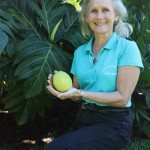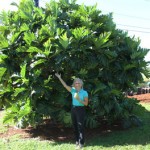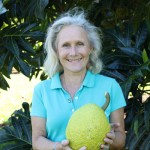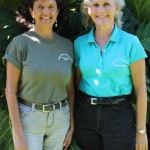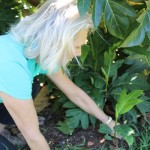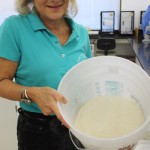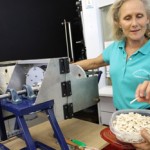Diane Ragone And The Wonder Fruit
The director of the Breadfruit Institute at National Tropical Botanical Garden aims to feed a hungry world with a nutritious and tasty plant that grows easily. She’s planning to plant breadfruit trees, once the primary staple in the Pacific, in 14 countries for the Global Hunger Initiative
Breadfruit is iconic for Pacific Islanders.
The nutritional aspect of the produce alone is reason enough for its highly regarded status.
“It’s a really rich, interesting plant to study,” says Diane Ragone, director of the Breadfruit Institute at the National Tropical Botanical Garden. “I’m never bored with it. Every day I find something new.”
Ragone has been researching the tree and its fruit since the 1980s, and believes it could be one of the keys to solving the global hunger crisis.
- Diane Ragone
- Diane Ragone beneath a breadfruit tree at NTBG headquarters in Kalaheo
- The Breadfruit Institute director with breadfruit in hand
Breadfruit, ‘ulu in Hawaiian, is easy to grow, requires minimal labor and is extremely nutritious, providing essential minerals potassium and magnesium.
Some varieties of bread-fruit even contain high levels of iron.
“And iron deficiency is a terrible, terrible problem in much of the developing world,” notes Ragone.
‘Ulu is akin to a starchy staple – the equivalent of having potatoes, rice or pasta,” explains Ragone. “When the fruit is young and immature, its taste is likened to artichoke hearts; when mature, the taste is similar to a potato; and when ripe, it’s soft and sweet like a fruit. It has more flavor than potatoes. It has a unique flavor.”
Everything from soups and salads to desserts can be concocted with the versatile produce. Ragone, whose organization recently created a breadfruit cookbook, personally enjoys making breadfruit gratin, but loves one of its traditional recipes: roasted with coconut and sea salt.
The tree also is economically and environmentally sustainable. Not only does it provide food security as it can be grown locally, the trees produce fruit for decades.
“When I go to the grocery store here and I look now at what a potato costs to buy, I realize I could go out to my breadfruit tree and pick a fruit that I don’t have to pay anything for, and make the same kind of dish with something that I grew myself,” says Ragone, who has authored or co-authored some 80 research papers on breadfruit.
The plant was distributed throughout the Pacific Islands some 2,000 to 3,000 years ago and served as an important staple crop. Unfortunately, the multipurpose tree’s use and cultivation has declined in the past several decades. In Hawaii, because of the abrupt and dramatic cultural changes that occurred, particularly during the 1920s, bread-fruit was no longer considered an important crop.
However, there recently has been a resurgence of breadfruit growth, especially in the Pacific, largely thanks to Ragone’s efforts to promote its use across the globe.
As director of the Breadfruit Institute, Ragone is responsible for promoting the conservation of the plant and developing new ways of propagating the species. There are 50 breadfruit trees at NTBG on the South Shore, consisting of 20 different varieties. At NTBG’s garden on Maui, there are 285 trees and 120 varieties.
Throughout the years, Ragone has collected approximately 400 different varieties from various places, including the Cook Islands and Fiji, and successfully cultivated around 120. Her focus on breadfruit began after she moved to Honolulu to earn a master’s degree and Ph.D. in horticulture at the University of Hawaii.
“I really knew nothing about breadfruit before,” she admits.
- Ragone with Angela Tillson, Breadfruit Institute program manager
- Ragone plucks a root sucker from under a breadfruit tree, which can be used for propagation
- Breadfruit flour is a gluten-free alternative that can be used for baking
- Ragone demonstrates how breadfruit flour is made at NTBG headquarters in Kalahe
The Virginia native was taking a class about Tahiti when the culture’s traditional food source initially sparked her interest. Ragone set out to learn more about the plant, and started collecting samples and forming a conservation collection. She since has traveled to about 50 Pacific Islands and has been developing a living collection since 1985.
Her fascination with plants in general began her senior year in high school after taking a botany class.
“I just really enjoyed it. It opened up a whole new area of knowledge and information for me,” she says. “Plants are just such a fundamental life form in the ecosystem and on the planet.”
Following high school, Ragone earned a bachelor’s degree in horticulture from Virginia Tech. Her first job in the field was at a garden center in Virginia.
“I really learned hands-on, practical horticulture,” she says.
The position required her to do many tasks, such as growing annual plants, bedding plants and tending to landscaping elements like burlapping. Her next job was at the U.S. Department of Agriculture, where she produced daily market news reports for fruits and vegetables in Philadelphia.
“That’s what growers and the whole industry looked at, trying to set prices for produce,” she says.
The job led her to others in Chicago and San Francisco.
“What was interesting to me was to see the huge volume of food that was coming in and to see all these exotic tropical fruits that I had never seen or heard of growing up,” she says.
The cold weather in Chicago inspired her to move somewhere warmer.
Since she had siblings who lived in Hawaii, it seemed the natural choice. Ragone discovered a job she was interested in on Kaua’i, and moved to the island in hope that she would eventually land an entry-level gardener position at the former 16-acre Ola Pua Garden. After working there for a year, Ragone moved back to the Mainland to work for an indoor house plant nursery in California for a summer season, and then ventured to Australia for a year to work on a tropical fruit farm. But Hawaii inevitably drew her back, and here she was able to discover her dedication to perpetuate breadfruit.
Angela Tillson, program manager at the Breadfruit Institute, is impressed with Ragone’s unwavering devotion to the plant.
“She’s one of the best bosses I’ve ever had,” she says. “She’s a very intelligent, fun and passionate person.”
Tillson also believes the 10-year-old Breadfruit Institute is an “outstanding program.”
“I like the fact that it can feed the world,” she says. “We can do that from our office on Kaua’i.”
In addition to the actual fruit being a significant food source on its own, Tillson and Ragone are in the process of creating gluten-free breadfruit flour on a commercial scale.
The organization also is responsible for planning tree-planting projects in 14 countries as part of its Global Hunger Initiative, and is continuing to develop new partnerships and collaborations in places such as Samoa.
Plant a Tree of Life-Grow ‘Ulu is another project in which some 4,000 trees will be distributed to Native Hawaiians, Pacific Islanders and low-income residents.
Additionally, the Breadfruit Institute will hold its first festival on Kaua’i Sept. 15 at the NTBG South Shore Visitors’ Center.
The event will include a cooking contest, cooking demonstrations and many cultural activities and games.
“It will be just a whole mix of things to celebrate breadfruit,” says Ragone, who originally was hired at NTBG in 1989 to set up and run the garden’s native plant conservation program.
When she isn’t finding a way to promote the use of breadfruit, Ragone spends time with her photographer and videographer husband Jim Wiseman, who helped her document photos of bread-fruit for the institute’s website. She also loves swimming in the ocean and snorkeling.
But it’s breadfruit that seems to elicit the most sparkle in her eyes.
“Here on Kaua’i and in Hawaii, we are proud to have this collection, and this institute that is a real locally, regionally and globally important research project,” she says.
Visit ntbg.org/breadfruit for more information.

